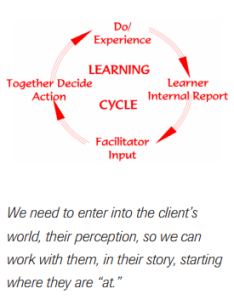
Delving/Dabbling/Diving into Experience Driven Learning
by Cookie Hale
Skiing and helping someone learn to ski is a “whole body” experience that encompasses our emotions, our minds, our spirits as well as our bodies. It is an adventure deep into the human soul where you make value connections with another being. Skiing transports us to the “now” entirely, and we share that now with another being. Learning in this magical now, is an experience that transcends the physical, yet is authored by the physical.
“Teaching” skiing is not just about skiing, it’s about learning more about who people are, including ourselves, and how we work, play, explore and learn together. Any system of learning and facilitating learning must be grounded in an understanding of our social and learning context as well as the technical aspects of skiing.
Facilitated Experience Driven Learning is a systems model that is progressing and evolving. Last season, “experiential learning” became a buzzword, however a buzzword with multiple interpretations. This article is the first in a series that will try to clarify FEDL by briefly running through some foundational concepts which, due to their brevity, are intended to also pique curiosity and spur more research.
FEDL utilizes a model of how the brain processes the environment that reflects the current state of neuroscience. There is more than one way of looking at the world. One classic way is the materialistic view that the world consists of independent objects that we see and then act on. These objects have no intrinsic value, thus, the issue of meaning is not included in this account.
Another way of looking at the world is the narrative view. This is quite different from the traditional materialistic view. You inhabit stories, frames of reference on your temporal journey from Point A to Point B. You implement your stories through action, acting out what you believe. Action is everything. Things around you in the world manifest themselves to you as patterns of utility — things that help you along your way: opportunities, tools and things that hinder you, obstacles. What an object can do, can be used for, gives it its meaning. So you mostly perceive the world as it relates to you and your desires. We live in a landscape of relevance, not a landscape of facts.
This narrative way of looking at the world considers the nature of experience rather than objects as real even though it includes thingsthat cannot be easily identified such as emotions, motivational states, fantasies, and ideals. Your motivations, your desires, set the frames of reference. This encompasses such things as your desired goals, your drive, as well as your survival reflexes.
 Neuroscience has taught us that when we look at the world, we not only look at it with our visual system, but also with our motor output systems and our emotions. When you look at something like a chair, that is just there, motionless, our mechanical or motor output systems that we would employ to use the chair are also activated during the act of perception. When we see a chair, we “think something to sit on” in the motor output region of our brain. We will conceptualize an object with our body as well as with our emotions before we have any idea of what the object is.
Neuroscience has taught us that when we look at the world, we not only look at it with our visual system, but also with our motor output systems and our emotions. When you look at something like a chair, that is just there, motionless, our mechanical or motor output systems that we would employ to use the chair are also activated during the act of perception. When we see a chair, we “think something to sit on” in the motor output region of our brain. We will conceptualize an object with our body as well as with our emotions before we have any idea of what the object is.
As you live through your narrative stories, your emotions signal and track progress. Progress towards your goal elicits positive affect. This progress towards our goal releases dopamine and increases motivation. Neurochemically, dopamine helps regulate both movement and emotional response. Positive emotion is only possible by progress towards a desired goal.
Obstacles elicit negative affect, stress. Perceiving an object which we do not completely understand often elicits stress where cortisol inhibits rational thought and allows our motor output and emotional systems to control us. Both dopamine and cortisol are regulated by systems of the hypothalamus. The hypothalamus is a very primitive and archaic structure in our brain. It is where our survival motivations are housed: food, water, thermoregulation, defense, and procreation along with exploration. Yes, exploration and curiosity are housed and regulated by the primitive hypothalamus! When our other survival desires are satisfied, the hypothalamus tells us to explore. We are naturally curious beings that forage for information. We are learners.
Think of the major role the hypothalamus can play in our clients: (1) positive emotion (dopamine response) is only possibly by perceiving progress toward a desired goal, and (2) under stress (cortisol response), it will inhibit rational thought and only allow their motor output systems and emotions to control them. So consider new and “scary” terrain or snow conditions or even the possible impact and role of detailed, complicated technical explanations.
Regarding our perceptions, neuroscience has shown that these frames of reference structure our perceptions. You mostly attend to things that are relevant to your story, to your aim. Is something useful or an obstacle? It is through our stories, our frames of reference, that the world manifests itself. This is of major importance when you are trying to understand another person’s world and help them learn. They will only pay attention to what their stories, their frames of reference, show them to be relevant. However, you as the instructor, can help them pay attention to and become aware of “things” that are relevant to their goal. Remember that these frames of reference, these stories are created by theirmotivations and progress is signaled and tracked by their emotions.
Therefore, in teaching, first the motivation, the aim, the direction, the desire needs to be formulated because this will dictate what the learner will perceive. They need to own this. Then progress towards the goal will elicit positive emotion and further facilitate movement forward.
Piaget has much to say about how we interact with others. Your story has to process through time as interact well as with other people’s stories. Piaget’s concepts about “games” and rules are so very valid. Together we develop “games” where we can play and work together, each understanding and following the “rules.” These games organize our behavior across people, with rules being our value structures. You are a co-creator of your own being and through your action, the being of other people as well and the external world as you act upon it.
The impact this has on facilitating learning in our clients is immense. The instructor needs to first understand the client’s rules and game. We need to enter into the client’s world, their perception, so we can work with them, in their story, starting where they are “at.”
How do you do that? We actively engage them and ask them to share their perceptions, body sensory feelings and experience with us. This was first called the “Internal Report” by a group of Austrians from Vienna at the 2015 Interski in Ushuaia, Argentina. It is not enough to be the expert in what you see, in movement analysis. You must also understand their motivation, what are they trying to do, what do they think they should do and why, as well as their emotional climate. You can only find this out by asking them. Then, most importantly, you LISTEN and act on what you hear. Similarly, as their experience develops, you want to stay engaged with them. Communication is key — the client needs to tell us and talk to us as they perceive, process, and experience. Verbalizing also helps them to process and make sense out of their experience, which will further their intrinsic motivation and autonomy and engagement.
In summary, the world of our clients will often consist of desires such as where they want to go and how fast. Someone cannot truthfully and logically talk about something they do not yet know through experience. We need to find out their “now.” Then our clients can benefit from our input by helping them aim their attention to what is relevant to their goals. We can do this by asking questions and helping them to think and make sense out of their experiences. As they become more aware of their experience, the cause and effect of the skis on the snow, we can even begin to lead them into some technical concepts. However, we do this only when they already have that framework first through their own experience and have started to verbalize it. Jointly we can set new targets and help them learn what to feel and attend to while they play and prove what works best. They will become fully engaged and responsible for their own learning.
Fundamentals Summary
- Positive Emotions: Our circuits that produce positive emotion are only activated when progressing towards a valued goal.
- Body and Emotional Perception Precedes Cognition: We will conceptualize things with our body as well as with our emotions before we have any idea of what the object is. Stress inhibits rational thought and allows our motor output and emotional systems to control us.
- Internal Report: We actively and continually engage our clients and ask them to share their perceptions, body sensory feelings and experience with us.
- Action, Awareness and Truth lead to Engagement: Jointly setting targets and outcomes and then paying attention to body sensory feelings are key elements for accelerating learning. Facilitated Experience Driven Learning.
These are just a few of the basic premises of FEDL. FEDL will be more fully developed in future articles. In the meantime, I invite your comments and hope to have an interactive forum created by this fall!
Cookie Hale, M.S. Teaching Gifted and Talented, is a full-time Level 3 PSIA instructor teaching at Jackson Hole Mountain Resort.

